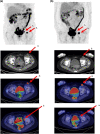18 F-FDG PET/CT features of immune-related adverse events and pitfalls following immunotherapy
- PMID: 35191204
- PMCID: PMC9303622
- DOI: 10.1111/1754-9485.13390
18 F-FDG PET/CT features of immune-related adverse events and pitfalls following immunotherapy
Abstract
18 F-FDG PET/CT scanning is routinely performed to stage and evaluate the treatment response in many malignancies. Immunotherapy is a rapidly growing treatment option for many cancers, and both clinicians and imaging specialists need to be familiar with 18 F-FDG PET/CT imaging characteristics unique to patients on this type of treatment. In particular, many immune-related adverse events (irAEs) can be detected on 18 F-FDG PET/CT and early accurate identification is critical to reduce treatment related morbidity and incorrect interpretation of malignant disease status. This pictorial essay reviews frequently encountered irAEs in clinical practice and their appearances on 18 F-FDG PET/CT along with a brief discussion on pseudoprogression and hyperprogression.
Keywords: 18F-FDG PET; nuclear imaging; nuclear medicine; oncologic imaging.
© 2022 The Authors. Journal of Medical Imaging and Radiation Oncology published by John Wiley & Sons Australia, Ltd on behalf of Royal Australian and New Zealand College of Radiologists.
Figures













References
-
- Robert C, Long GV, Brady B et al. Nivolumab in previously untreated melanoma without BRAF mutation. N Engl J Med 2015; 372: 320–30. - PubMed
-
- Reck M, Rodriguez‐Abreu D, Robinson AG et al. Pembrolizumab versus chemotherapy for PD‐L1‐positive non‐small‐cell lung cancer. N Engl J Med 2016; 375: 1823–33. - PubMed
-
- Chan KK, Bass AR. Autoimmune complications of immunotherapy: pathophysiology and management. BMJ 2020; 369: m736. - PubMed
-
- Larsabal M, Marti A, Jacquemin C et al. Vitiligo‐like lesions occurring in patients receiving anti‐programmed cell death‐1 therapies are clinically and biologically distinct from vitiligo. J Am Acad Dermatol 2017; 76: 863–70. - PubMed
MeSH terms
Substances
LinkOut - more resources
Full Text Sources
Medical

